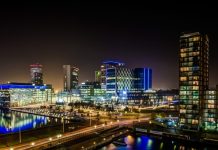Using archways for arts and entrepreneurial businesses, having a high-rise and train carriage market park on the old station with botanical elements, arts and entrepreneurial discount housing and studio spaces for new businesses, an array of creative tourist destinations, with affordable eco-housing.
These are just some of the suggestions being put forward as part of an alternative proposal for the future planning of the former train station in the Centre of the City.
The Mayfield Imaginarium Collaborative have launched their report into the future of the Mayfield area and say that their sample and findings not only far exceed Manchester City Council’s public consultation research numbers, but reveal that public aspirations are vastly different to the conclusions of the Council’s report.
They have now met the developer U&I manager and representatives to present their thorough report. Communicating with the group throughout their research, U+I have said that they are delighted to have received the results and visions from the research of well over 500 people.
They have even requested to meet the CEO Richard Upton and asked him to present some of their finding at their MIPIM presentation. Upton describes Mayfield as a “‘bottom- up regeneration’ which is going to deliver something world class for Manchester” and the collaborative certainly have made this mark as a community led imaginative consultation.
The collaborative included a group of academics, architects, planners, artists and campaigners. Public engagement and data collection including a weekend of professional workshops attended by over 120 people in which many core research activities took place.
These core activities engaged the attending public to respond to Mayfield’s opportunities via creatively diverse engagement activities.
Based on the findings of their public workshops, the collaborative ran a survey which was completed by 429 people. The collaborative produced their report and undertook their research as unpaid volunteers with no formal funding. The public consultations by Manchester City Council only received 108 responses say the campaigners.
All the findings are summarised in a report made by an architectural start-up ‘architecture:unknown’, which has been released into the public domain, highlighting the main results.
The Mayfield site, abandoned as a train station in the 1960s, equates to 4% of the whole of the city centre and will be one of the most important new built projects of the coming decade. The new district of Mayfield will likely see around £850 million worth of investment.
The collaborative are already requesting that when the official public consultations come out later in 2017, that U+I will work with a range of professional, academic, third sector, civic and community groups to enable the Mayfield development to reach its optimum potential, which we all desire.
Hometown Plus have recently started working with the collaborative and their findings. The organisation hopes to facilitate cross-sector introductions and broker new partnerships for commercial good and community benefit. There is hope that this alliance can facilitate the community’s aspirations for the area including the re-use and preservation of heritage, long-term community infrastructure and investment in the creativity, innovation and health of all aspects of this new neighbourhood.
The top five words used when people asked what they would like to see Mayfield become were “creative, exciting, green, innovative and unique”.
People wanted to see Mayfield having a unique architectural style which valued its heritage, whilst preserving the ‘Star and Garter’ as an independent business and to make the area unique, not just for Manchester but regarding international reputation.
Daniel Kelso from ‘architecture: unknown’ commented “our findings differ greatly to the ‘Strategic Regeneration Framework’ findings of Manchester City Council. Those reports suggested the removal of Mayfield’s history, mainly advocating the demolition of the site. The word affordable was not once used in that report regarding housing. Their report did not cover creative bases which our public research has found, which illustrated that people hope, and dream Mayfield can be unique”.
Adam Prince from the civic empowerment pressure movement, Manchester Shield says “There is great discord in the city at the moment regarding how consultation and engagement are being handled by politicians and other developers. Mayfield is a vital opportunity to work with an incredible developer in a completely new district of Manchester. But more than that and beyond Mayfield, Shield will now be working to advocate new models of engagement and consultation, valuing citizens rather than ostracising them”.
John Hesketh from Hometown Plus says “It is a unique opportunity for a developer to work with the people of Manchester and truly create something special with regards to infrastructure and sustainable long-term neighbourhoods. These will leave positive social legacies and enable Manchester to improve and its people to pioneer and thrive”.







